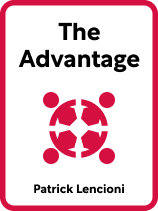

This article is an excerpt from the Shortform book guide to "The Advantage" by Patrick Lencioni. Shortform has the world's best summaries and analyses of books you should be reading.
Like this article? Sign up for a free trial here.
What is organizational health? Why is organizational health important?
Patrick Lencioni’s book The Advantage talks in great detail about organizational health and its role in helping businesses reach their fullest potential. Further, he claims that there are four steps that you can take to reach organizational health.
Read below for Lencioni’s definition of organizational health.
Organizational Health Definition
What is organizational health? Lencioni’s definition of organizational health encompasses two main factors. First, the organization’s goals and standards are clear, consistent, and regularly communicated to everyone in the organization. Second, individuals and groups align with the organization’s standards and are dedicated to the organization’s goals. Factor one is necessary for factor two to exist. When organizations implement these two factors of organizational health, Lencioni says they’ll be highly effective.
(Shortform note: Lencioni’s concept of organizational health (OH) isn’t new—the McKinsey group, a global management consulting firm, claims to have invented the concept roughly five years before The Advantage’s publication. Their definition of OH is very similar to Lencioni’s. However, they break organization health into three main standards: the ability to align around common goals and strategies, the ability to execute these goals and strategies at all levels of the organization, and the ability to adapt and innovate according to customer needs. Lencioni’s concepts of clear goals and standards and employee alignment are included in the McKinsey group’s first two standards, but McKinsey’s third standard takes Lencioni’s concept a step further.)
Why Is Organizational Health Important?
Lencioni explains that organizational health is important for two reasons. First, it enables organizations to meet their full potential. For strategies, financial investments, goals, and solutions to be effective, everyone must work towards the same overarching goals, uphold the same behavioral standards and values, and understand their role. Without these factors, even organizations with the best strategy, marketing, finances, and technology (what Lencioni calls intelligence) will fail to meet their full potential. Their progress will be hindered by politics and conflicting goals among leaders and departments. Further, work will lack meaning, and employee turnover will be higher.
(Shortform note: In Start With Why, Simon Sinek agrees that companies who focus on intelligence (what Sinek calls the company’s WHAT) while ignoring things like clear goals, standards, and values (what Sinek calls the company’s WHY) are destined to fail—confusion and disorganization will arise and employees will lose motivation and dedication. Sinek calls this phenomenon “the split.” He explains that companies are at the highest risk of the split when leaders become disconnected from the organization’s WHY. This disconnect usually occurs because the leader loses sight of the organization’s purpose after finding success, or because they’re replaced with someone who doesn’t share the same dedication to the organization’s WHY.)
Second, a healthy organization will be your invisible superpower because many leaders overlook it—they think it’s too intangible to focus on and achieve, are too impatient to complete the process of developing health, or don’t believe in its impact. If you’re dedicated, persistent, and disciplined enough to see it through, organizational health will give you the competitive advantage that others are too blind to see.
(Shortform note: Research supports Lencioni’s claim that organizational health will give your company a tangible advantage that’s overlooked by competitors. The McKinsey group found that over the course of a decade, companies that improved their organizational health reported an 18% increase in earnings and a 10% increase in returns to shareholders (TRS). For context, the average company on the S&P 500 (an index that tracks the stock performance of 500 large companies listed on exchanges in the United States) showed only a 7% average increase in earnings and a 9% average increase in TRS.)
How Do You Create Organizational Health?
Lencioni’s process to achieve a healthy organization can be broken into four main steps:
- Create a unified and efficient leadership team that runs the organization.
- Establish clear and consistent organizational goals and standards.
- Achieve employee alignment with and dedication to the organization’s goals and standards.
- Maintain organizational health by having effective meetings.

———End of Preview———
Like what you just read? Read the rest of the world's best book summary and analysis of Patrick Lencioni's "The Advantage" at Shortform.
Here's what you'll find in our full The Advantage summary:
- How the biggest business advantage you can gain is free and within your reach
- How to create an effective leadership team
- How to maintain organizational health with effective meetings






